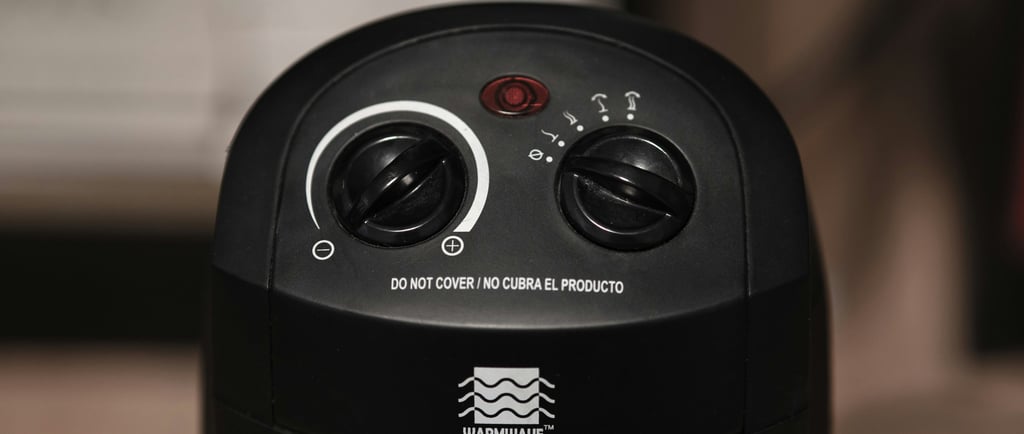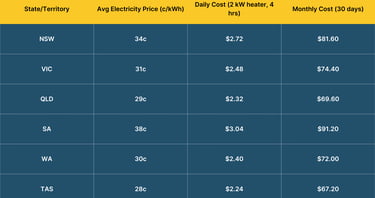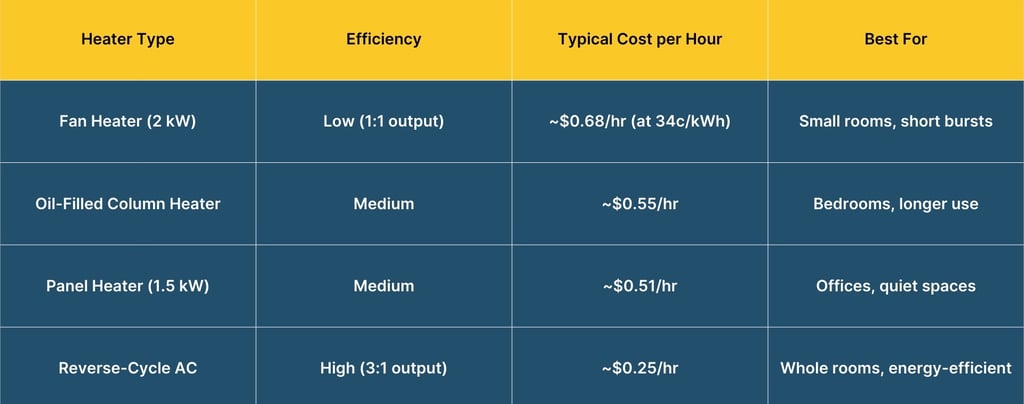That cheap heater might be costing more than you think
Think your $30 heater is cheap? At 40c/kWh, it could be costing you upwards of $6 a night to run. Use our free Heater Cost Calculator to see the real cost of staying warm.
8/19/20253 min read


How much does it really cost to run an electric heater?
Winter in Australia can be tough on both comfort and budgets. As temperatures drop, millions of households reach for the quick fix: a portable plug-in electric heater. They’re small, cheap to buy, and easy to move from room to room. But here’s the catch, those little heaters can quietly send your electricity bill soaring.
If you’ve ever wondered “How much is my heater really costing me to run?” you’re not alone. That’s exactly why we built the Heater Cost Calculator, a free tool to help Australians work out the true cost of heating and discover smarter, cheaper ways to stay warm.
Why portable electric heaters can be so expensive
On the surface, fan and bar heaters look like an affordable option. Most cost between $20 and $60 at Bunnings, Kmart or Target. But their low purchase price hides a high running cost.
Here’s why:
High wattage draw: Most fan heaters use 2000 watts (2 kW) of power.
Direct electricity use: Unlike reverse-cycle air conditioning, there’s no efficiency multiplier. A 2 kW heater consumes 2 kW of energy for every hour it’s running.
Continuous running: Many households use them for hours each night, especially in poorly insulated homes.
At an average electricity rate of 34 cents per kWh (2025 NSW average), that adds up quickly.
Example: A 2 kW heater running 4 hours per night costs: 2.0 kW × 4 hours × $0.34 = $2.72 per night That’s $82 per month or nearly $250 for winter, for just one room!
Try our free Heater Running Cost Calculator
Want the exact number for your heater? Use the EnergyPlans Heater Cost Calculator:
Want to know exactly how much your heater is costing you? We’ve built a free interactive tool that lets you paste the product URL of your heater (from sites like Kmart, Big W, Bunnings, or The Good Guys), and we’ll instantly estimate how much it costs to run.
It scans the heater’s wattage and gives you clear monthly and yearly cost estimates based on average energy rates, helping you make smarter, warmer decisions.
Average electricity rates in Australia (2025)
Energy prices vary across states, which means your heater’s cost depends on where you live.


Figures based on average market offers, 2025.
As you can see, South Australians pay the most, while Tasmanians enjoy slightly lower rates. But no matter where you are, running a plug-in heater adds up.
Are There Cheaper Heating Alternatives?
Yes. Not all heaters are created equal. Here’s how different options compare:


Reverse-cycle air conditioners are by far the most efficient, producing 3–4 times more heat per kWh compared to plug-in heaters.
DIY tips to reduce heater running costs
Even if you rely on a portable heater, there are simple ways to cut costs without shivering through winter:
Seal drafts: Use door snakes or window seals to keep warm air in.
Heat only occupied rooms: Don’t waste energy on empty spaces.
Layer up: Warm clothes and blankets reduce the need for long heating hours.
Use a timer: Avoid forgetting your heater on overnight.
Add thermal curtains: Stop heat escaping through windows.
Small tweaks like these can shave 20–30% off heating bills.
How much can you save by switching energy plans?
Even the best efficiency tricks won’t matter if you’re paying too much per kWh. Energy retailers in Australia charge very different rates, and many households are stuck on expensive “default” offers.
Examples:
Family in Sydney on 38c/kWh plan using heater 5 hrs/day = $114/month
Same usage on 28c/kWh plan = $84/month
That’s a saving of $360 each winter, just by switching plans.
Compare electricity and gas plans now
FAQs: Heater costs in Australia
Q: How much does it cost to run a 2000W heater for 8 hours?
A: At 34c/kWh, that’s about $5.44 per night, or over $160 per month.
Q: Are ceramic heaters cheaper to run?
A: Not really. They’re still electric resistive heaters, so they cost roughly the same as fan heaters.
Q: What is the cheapest way to heat a home in Australia?
A: A reverse-cycle split system, paired with good insulation. It’s up to 70% cheaper than plug-in heaters.
Conclusion: Don’t get burned by hidden heater costs
Portable heaters might look like a budget solution, but their running costs tell a different story. For many Australians, that “cheap” $30 heater ends up costing hundreds of dollars each winter.
Use our Heater Cost Calculator to find out your true running cost.
Explore cheaper alternatives like reverse-cycle air conditioning.
Compare and switch energy plans to save even more.
Try the Calculator & Compare Plans Now
Guidance
Helping you choose the best energy plan.
Support
info@energyplans.com.au
© 2025. All rights reserved.
Energy plans australia trading as energyplans.com.au
ABN: 37 686 762 158
